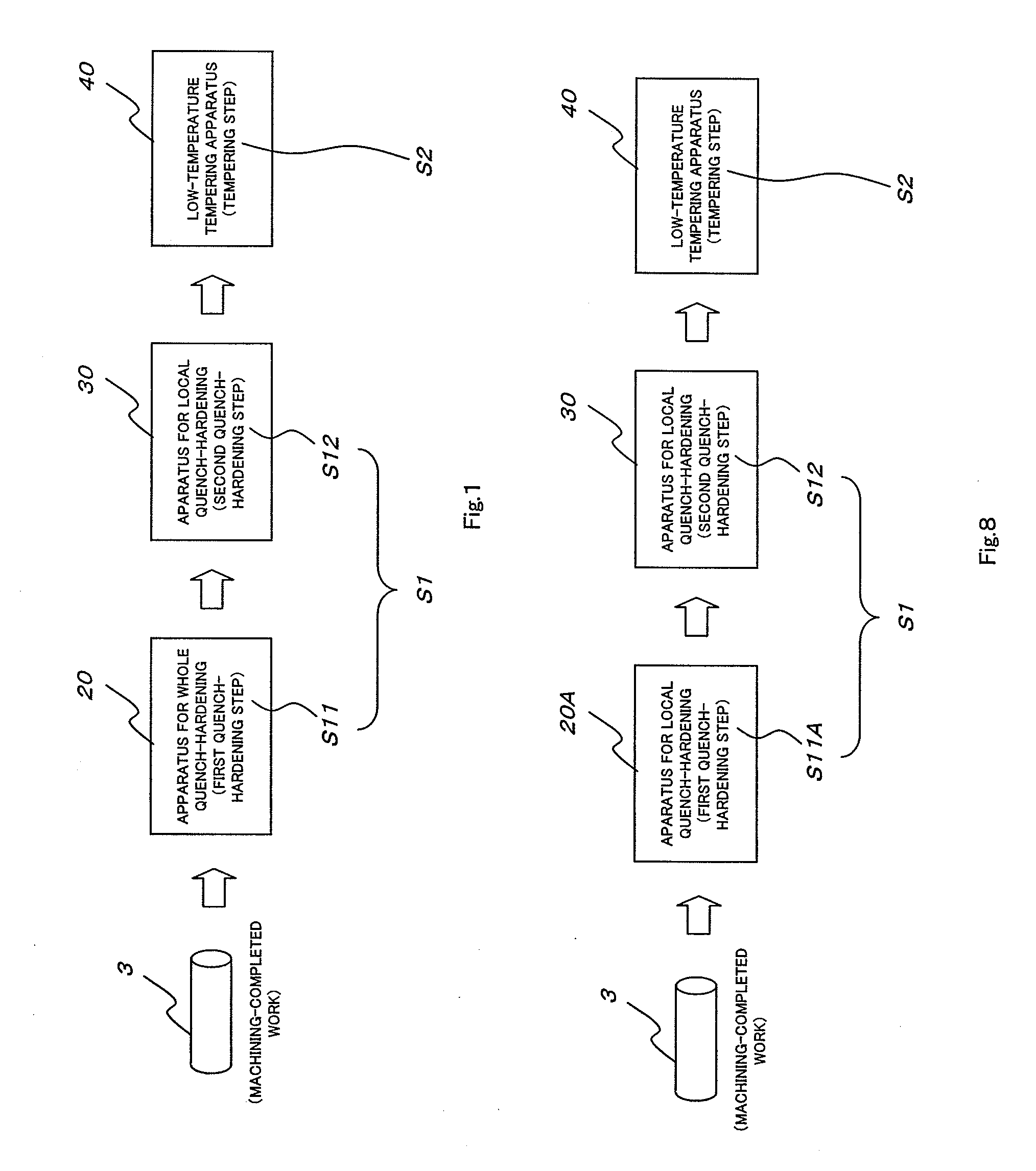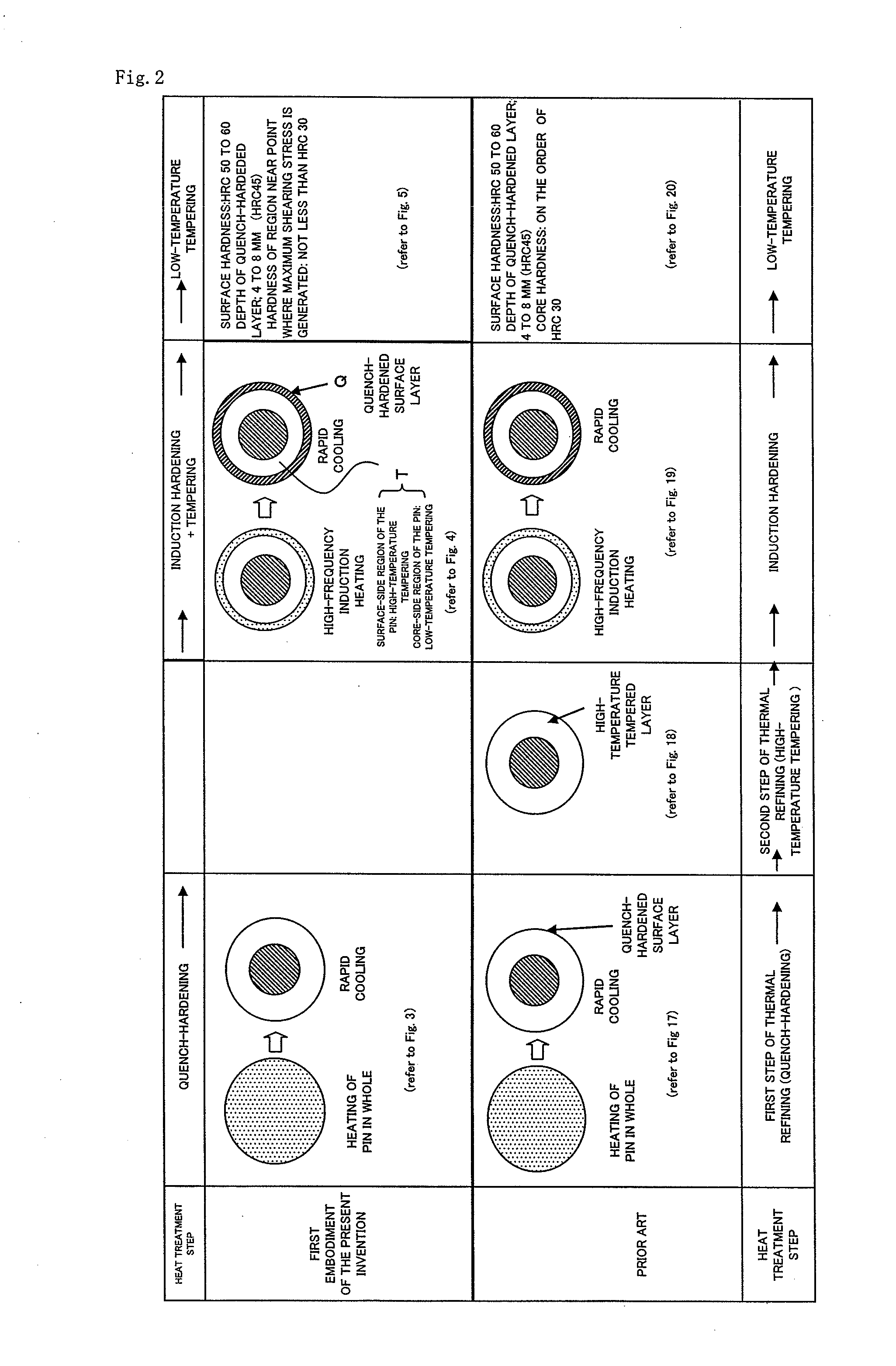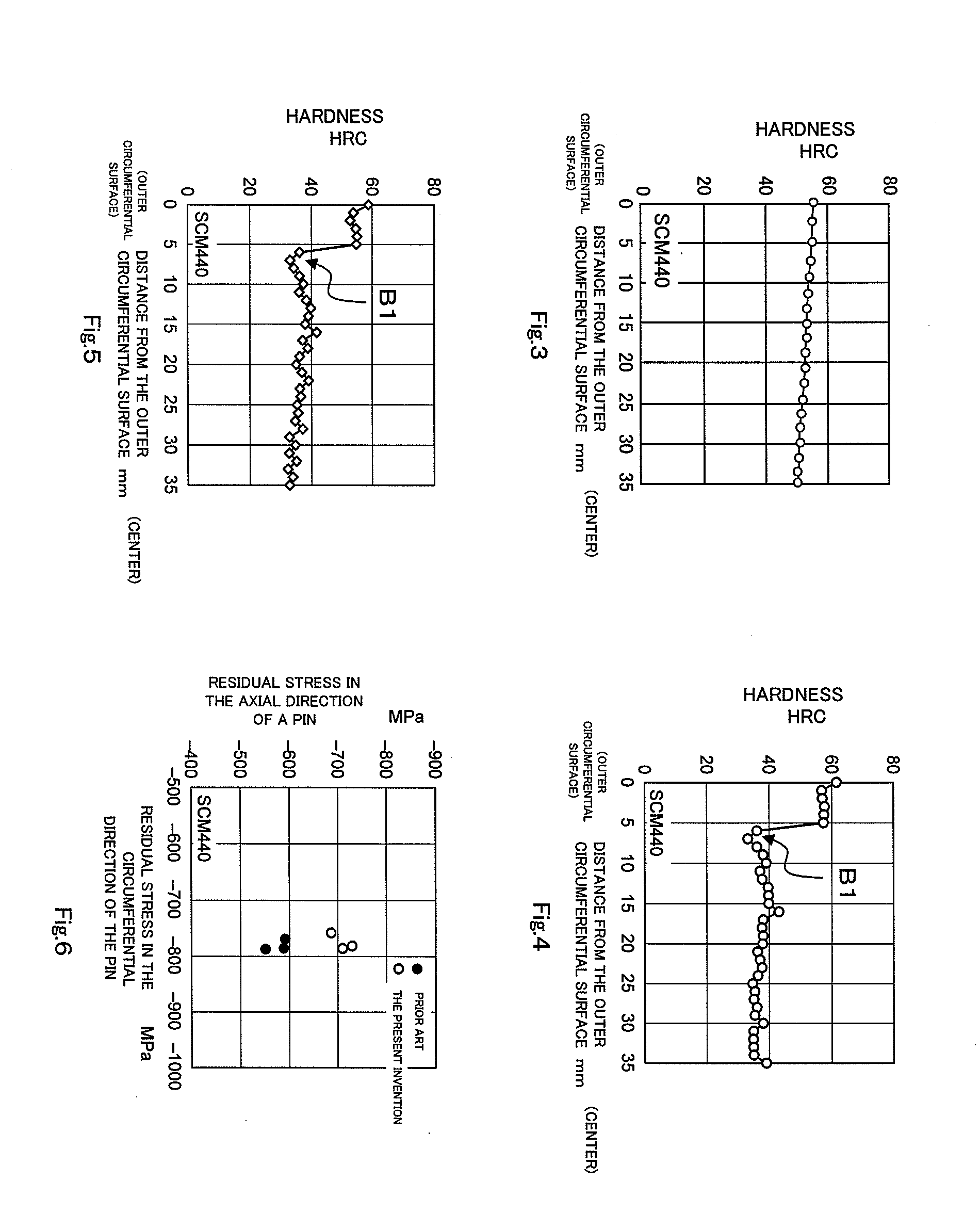Method for heat treatment of columnar work
Inactive Publication Date: 2010-10-07
TOPY INDUSTRIES
View PDF1 Cites 6 Cited by
- Summary
- Abstract
- Description
- Claims
- Application Information
AI Technical Summary
Benefits of technology
[0048]In the prior art, four steps are necessary for a heat treatment of a columnar work. By means of the present invention (claim 1, and claim 2) including the above-mentioned constitutions, number of steps being required for the heat treatment of the columnar work (3) are reduced to three steps, and therefore, a productivity is improved and manufacturing costs are reduced.
[0049]Further, since the outer circumferential surface region (31) of the columnar work (3) is merely quench-hardened in the second quench-hardening step (S12), a high compressive residual stress is generated on the outer circumferential surface region (31), thereby the fatigue strength of the columnar work (3) is improved.
[0050]In addition, since a hardness of an region near a position, at which the maximum shearing stress in cross-section of the pin is generated, is increased as compared with one in the prior art, it is possible to prevent fracture even if an excessive shearing stress is imposed thereon. Accordingly, it is not necessary to use a raw material having high hardenability for securing a required hardness of the core portion, so that a raw material with less addition (in amounts) of alloy e
Problems solved by technology
However, in a method for carburizing and quench-hardening, in order to increase a wear resistance and a strength of a pin, it is necessary to increase a carburized case depth, and to extend a carburizing time, and thereby, there is a problem that a cost is increased.
Also, there is a problem that a large quantity of a carburizing gas should be necessary, and then, a cost for the carburizing gas is increased.
However, in the above-mentioned prior art, since the quench-hardened layer depth of the pin is dependent on hardenability of the raw material, a diameter of the pin and so on, a necessary wear resistance and a strength will not be obtained in a case that a raw material having low hardenability is used.
On the other hand, in a case that a raw material having high hardenability is used, an excessive increase in the quench-hardened layer depth of the pin will be happened, and thereby, a compressive residual stress on the outer circumferential surface of the pin will be decreased, so that there will be a problem of a decreasing a frac
Method used
the structure of the environmentally friendly knitted fabric provided by the present invention; figure 2 Flow chart of the yarn wrapping machine for environmentally friendly knitted fabrics and storage devices; image 3 Is the parameter map of the yarn covering machine
View moreImage
Smart Image Click on the blue labels to locate them in the text.
Smart ImageViewing Examples
Examples
Experimental program
Comparison scheme
Effect test
Example
EXPLANATION OF REFERENCE NUMERALS AND SYMBOLS
[0193]1 . . . link,[0194]2 . . . shoe,[0195]3 . . . columnar work (pin for use in an endless track)[0196]4 . . . bushing[0197]20 . . . apparatus for whole quench-hardening[0198]30 . . . apparatus for local quench-hardening[0199]31 . . . outer circumferential surface region[0200]31f . . . outer circumferential surface[0201]32 . . . core[0202]40 . . . low-temperature tempering apparatus 40
the structure of the environmentally friendly knitted fabric provided by the present invention; figure 2 Flow chart of the yarn wrapping machine for environmentally friendly knitted fabrics and storage devices; image 3 Is the parameter map of the yarn covering machine
Login to View More PUM
| Property | Measurement | Unit |
|---|---|---|
| Radius | aaaaa | aaaaa |
| Depth | aaaaa | aaaaa |
Login to View More
Abstract
The present invention relates to a method for heat treatment of a columnar work. In order to provide the method for heat treatment of a columnar work being able to attain a high productivity, a reduction of cost, and an improvement of quality, as compared with the prior art, the method for heat treatment of a columnar work of the present invention includes a quench-hardening step (S1) and a tempering step (S2) being carried out after the quench-hardening step (S1), the quench-hardening step (S1) includes a first quench-hardening step (S11) and a second quench-hardening step (S12) being carried out after the first quench-hardening step (S11), the entire region of the columnar work (3) from an outer circumferential surface (31f) to a core thereof (32), or a partial region thereof, is heated up to a temperature not lower than a transformation temperature Ac3, and then, the work is quench-hardened.
Description
TECHNICAL FIELD[0001]The present invention relates to a method for heat treatment of a columnar work, in particular, a large-sized (large-diameter) columnar work. In this connection, “a columnar work” includes a pin as a constructional part of an endless track of, for example, a construction vehicle. However, “a columnar work” is limited to neither a pin, nor a large-sized work (a pin being large in diameter, in a case that the work is a pin).BACKGROUND ART[0002]An endless track 10 (refer to FIG. 13) used for a construction vehicle, such as an excavator, bulldozer, and so on, comprises a pair of links 1, a shoe 2, a pin 3, and a bushing 4, as shown in FIG. 14.[0003]In FIG. 15, a columnar work such as a pin 3 used for an endless track, in an outer circumferential surface region 31 thereof (an outer circumferential surface, and a region in the vicinity thereof), is required so as to have a strength being capable for withstanding bending stress and torsion stress, and wear resistance, ...
Claims
the structure of the environmentally friendly knitted fabric provided by the present invention; figure 2 Flow chart of the yarn wrapping machine for environmentally friendly knitted fabrics and storage devices; image 3 Is the parameter map of the yarn covering machine
Login to View More Application Information
Patent Timeline
 Login to View More
Login to View More IPC IPC(8): C21D1/42C21D1/00
CPCB62D55/211C21D1/06C21D1/10C21D1/18C21D1/42C21D9/0068C22C38/22C21D9/0093C21D9/08C21D2211/008C22C38/02C22C38/04C21D9/0075C21D1/25C21D1/78C21D2221/10Y02P10/25
Inventor XUE, WEIDONG
Owner TOPY INDUSTRIES
Features
- R&D
- Intellectual Property
- Life Sciences
- Materials
- Tech Scout
Why Patsnap Eureka
- Unparalleled Data Quality
- Higher Quality Content
- 60% Fewer Hallucinations
Social media
Patsnap Eureka Blog
Learn More Browse by: Latest US Patents, China's latest patents, Technical Efficacy Thesaurus, Application Domain, Technology Topic, Popular Technical Reports.
© 2025 PatSnap. All rights reserved.Legal|Privacy policy|Modern Slavery Act Transparency Statement|Sitemap|About US| Contact US: help@patsnap.com



